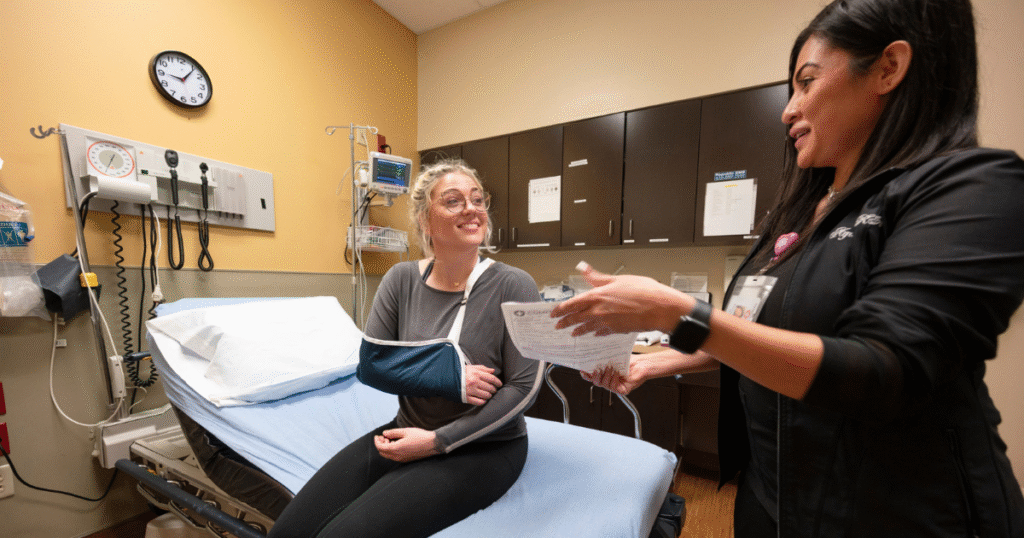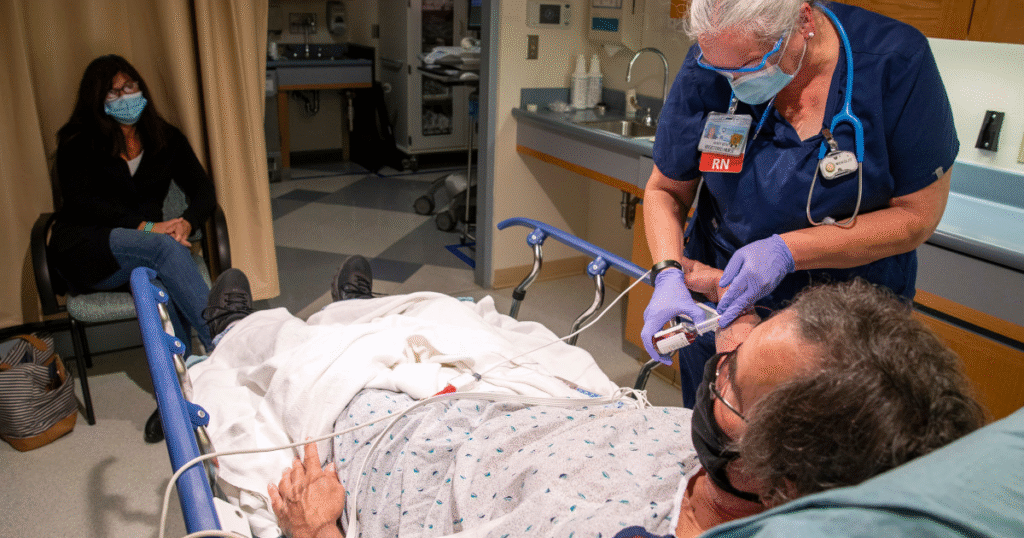Academic emergency medicine (EM) resides at the crossroads of clinical practice and medical education and is an integral part of developing the future of medicine. Emergency medicine serves acute medical needs, but academic emergency medicine represents the intersection of the acute needs of the patient and the scholarly contributions of research and education. As emergency physicians are charged with recognizing, managing, and treating the needs of the patient expeditiously, they are also charged to look ahead and thoughtfully consider how their work contributes to and moves forward with medical student education, residency education, faculty development, research, or some combination of the latter. This article discusses the multiple facets of the EM life, establishes pathways for development from medical student to EM physician, outlines what faculty do with respect to clinical responsibility, educational responsibility, and research opportunities, and introduces a discussion of faculty in practice that incorporates how they balance their ability to conduct clinical work and academic responsibilities.
What is Academic Emergency Medicine and its Importance in Medicine?
Defining Academic Emergency Medicine
Academic emergency medicine incorporates the educational and research duties of all emergency medicine physicians. It allows emergency medicine physicians to participate in teaching, developing curriculums, and affecting research on the knowledge of emergency care by integrating clinical practice and research. It is an academic component that is important for training the next generation of emergency medicine residents and medical students. Academic emergency medicine establishes a culture of inquiry and evidence-based practice to advance patient care and medical education and ensures that emergency physicians will be equipped to practice appropriately.
The Role of Emergency Medicine in Healthcare
Emergency medicine plays a vital role in the health care delivery system by providing critical care to patients with acute illnesses. As a specialty, emergency medicine requires rapid decision-making and clinical skills as providers must quickly evaluate and treat many different medical emergencies. The emergency department (ED) frequently acts as a patient’s first contact with a health care system; for every patient who presents to an ED in crisis, emergency medicine and emergency physicians are significant to their triage and management. In this high-pressure professional environment, applying the principles of academic emergency medicine is a means of improving patient outcomes, as emergency physicians use the newest findings from research to help with their clinical care practices. In addition, the field of academic emergency medicine affords opportunities to advance public health initiatives by identifying community priorities regarding poor health and developing interventions to prevent illness and disease.

Key Components of Academic Life in Emergency Medicine
Academic emergency medicine is an academic discipline where faculty have a varied time to devote to education and/or scholarship (typically >40% of faculty time). Faculty in academic emergency medicine are often great educational mentors to medical students and emergency medicine residents, where knowledge is applied in practice. Academic emergency medicine has a commitment to scholarship and developing the evidence base for medicine. Faculty directed in research projects contribute to new knowledge in the profession and medical discovery. The collaborative working environment affords enormous academic opportunity for emergency physicians. Faculty development programs help improve teaching, educational leadership, and the scholarship of teaching and learning in the academic emergency medicine programs. Academic emergency medicine can drive and develop the future of the specialty and enhance patient care by the collaboration of education and research.
How Does One Transition from Medical Student to Emergency Medicine Physician?
Pathways to Residency in Emergency Medicine
The medical student-to-physician transition in emergency medicine will commence with an interest in emergency medicine during medical school. Many future emergency medicine residents are eager to pursue experiences that are in line with their future goals by engaging in relevant clerkships and rotations. Emergency medicine residency programs are competitive, and the process involves a commitment to understanding the demanding aspects of emergency medicine. Residency program candidates must exhibit sound clinical judgement, leadership skills, and enthusiasm for patient care to secure a position in an emergency medicine residency program. The pathway to becoming an emergency physician includes a serious commitment to emergency medicine values, as well as commitment to ongoing learning on a daily basis.
The Importance of Clerkships in Medical School
Clerkships are an important part of medical education as they are often the first opportunity a medical student gets hands-on experience in various specialties, including emergency medicine. Emergency medicine clerkships give medical students the experience to learn about acute medical conditions in a high-paced emergency department environment. Clerkships provide the perfect opportunity for medical students to put their theoretical knowledge into action, pushing their clinical skills and clinical judgement further. Learning from faculty and mentors is one of the best aspect of clerkships, and receiving constructive feedback while learning in real time prepares students for the challenges of residency and beyond.
Gaining Experience through Rotations in the Emergency Department
Rotating through the emergency department as a medical student is essential to becoming an emergency physician. You are privy to the variety of cases that people come to the emergency department (ED) for either as an emergency-need patient or the non-emergently “abused” patient, and the various presentations and management. You get to see a variety of patients, from pediatric emergencies to trauma cases. You will also learn how to carefully and methodically evaluate patients with a time crunch (which is not something you are used to), and rely on the supervising emergency physician who has experience with the evaluation, communication with patients and families, and with managing the entire emergency department. This student role solidifies your interest in emergency medicine while you gain valuable skills that you will use throughout your career. By engaging the patient care you have an opportunity to enhance your critical thinking and rapid decision-making bundle in a busy multi-occupational work environment compounded with emotional baggage from other professions.
What Are the Responsibilities of Faculty Members in Emergency Medicine?
Teaching and Mentoring Medical Students
Faculty in academic emergency medicine are the primary educators of medical students and residents in emergency medicine. They provide didactic lectures, lead small group sessions, and supervise residents in their clinical rotations in the emergency department. Faculty transmission of knowledge about emergency medicine emphasizes evidence-based medicine, ethics, and professionalism in the care of patients. Faculty mentorship is a core function in their role, as they mentor students and residents in all facets of their careers. Faculty transmit information through personal experiences with learners and provide formative feedback to help the learner develop as the next generation of emergency doctors.
Administrative Duties of Emergency Medicine Faculty
Faculty in Emergency Medicine have teaching obligations as well as administrative obligations that contribute to the academic productivity of their academic department. These responsibilities could entail engagement in developing the curriculum, assessing their programs, as well as membership on committees relating to medical oucation.
In addition to their teaching role, faculty also partner with the program directors to ensure that the residency is compliant with accreditation standards and provides a quality educational environment for their learners. Faculty also will have a variety of administrative duties involving membership of other organizations such as the Society for Academic Emergency Medicine (SAEM) and the Academy for Integrating Learning with Evidence-based Medicine (ALIEM) that enhance the academic tranparency of productivity and othwerwise will provide an opportunity to advance productive collaboration across the academic emergency medicine discipline.

Engaging in Faculty Development and Career Growth
Faculty development is essential for both emergency medicine faculty as it improves teaching, research, and overall professional development. Institutions frequently house development resources and programs focused on faculty development. There can be workshops, seminars and offers of mentorship aimed at developing certain skills, such as grant writing, research, and teaching. Faculty members are often reminded to engage in learning and to seek out developmental opportunities for career advancement while employed in educational positions in which they teach and contribute to the profession of emergency medicine through creative practice and scholarly activities.
What Are the Opportunities for Research and Publication in Emergency Medicine?
Understanding the Publication Process in Academic Medicine
Research and publication are a crucial part of academic emergency medicine as faculty and resident physicians can share their contributions to the specialty’s body of knowledge. Publication involves several steps, including: developing a research question, performing a study, and disseminating findings via submission to a journal. An understanding of the similarities and differences of the publication process in emergency medicine is essential for emergency medicine physicians to be able to communicate their research and ultimately engage with the entire medical community. Resources like the Wiley Online Library provide easy access to a wealth of academic literature to foster the exchange of research outcomes.
Participating in Research Projects and Abstracts
Emergency medicine faculty and residents are motivated to engage in research that addresses pressing clinical questions and improves patient care, whether through clinical trials or quality improvement. In addition to undertaking research, authors often additionally prepare abstracts to submit to conferences and journals so that they can share their outcomes with peers. At the same time an author’s research promotes opportunities for academic productivity, it begins to create a culture of inquiry within the emergency department (ED) – where faculty and trainees can work cooperatively and collaboratively on future projects.
Presenting at Conferences like the SAEM Annual Meeting
Presenting research at conferences such as the SAEM Annual Meeting allows emergency medicine physicians to share their work and interact with other professionals. Conference programs typically offer a variety sessions (e.g., workshops, poster presentations, and oral presentations) allowing participants to experience many aspects of emergency medicine research. Presenting results at distinguished conferences increases the visibility of the research and provides an opportunity for professional growth of the presenters by providing an opportunity for feedback and discussions with other professionals.
How Can Emergency Medicine Physicians Balance Clinical Practice and Academic Responsibilities?
Navigating Shifts in the Emergency Department
Emergency medicine physicians face significant time demands when fulfilling clinical practice and academic responsibilities, especially when working in the emergency department. Planning shifts in the ED for emergency physicians requires prioritizing their time and tasks to appropriately care for their patients while completing their academic obligations. For emergency physicians, consideration must be given to new approaches for teaching and conducting research that blends well in the scope of practice and purpose of their job, so that they do not disengage from patient care and medical and academic responsibilities.
Integrating Clinical Work with Teaching and Research
Highly successful emergency medicine physicians are often creative in combining their clinical work, teaching duties, and academic research obligations. This is often manifested in a number of ways, ranging from running the research projects for emergency medicine, right within the emergency department, during the course of their clinical shift, to using real-time case studies to enhance their teaching encounters. When emergency physicians are able to connect their academic endeavors to their clinical practice, it can greatly enhance medical students, and residents learning experiences, and contribute to further development of emergency medicine. This collaborative approach promotes continuous cultural improvement benefiting patients and making the role of the `educator/clinician` more professional.

Metrics for Evaluating Performance in Academic Emergency Medicine
Assessing performance in academic emergency medicine necessitates a multifaceted approach to evaluate both clinical and academic performance. Performance measures may include clinical productivity, effectiveness as a teacher, scholarship or research, and initial faculty training and education. Institutions often use a combination of qualitative and quantitative measures to evaluate faculty member influence on medical education and care delivered to patients. Emergency medicine departments can demonstrate accountability and a culture of excellence by making the evaluation process clear and explicit and subsequently improving the quality of care and education for emergency department patients, ultimately enhancing their experience.
FAQs
Q: What is the focus of the EM specialty in Academic Emergency Medicine?
A: The EM specialty in Academic Emergency Medicine focuses on various aspects of emergency medicine, including patient care, research, education, and advocacy within an academic environment.
Q: How does one become a program director for an EM residency?
A: To become a program director for an EM residency, individuals typically need significant experience in emergency medicine, including completion of an EM residency and potentially a fellowship, along with a strong commitment to education and leadership in residency programs.
Q: What are the benefits of pursuing a fellowship in pediatric EM?
A: Pursuing a fellowship in pediatric EM provides advanced training in emergency care for infants, children, and adolescents, which enhances clinical skills, expands knowledge, and opens opportunities for teaching, research, and leadership within the specialty.
Q: How can ultrasound be integrated into EM education and practice?
A: Ultrasound can be integrated into EM education and practice through hands-on training in the residency curriculum, utilizing ultrasound for bedside assessments, and incorporating it into lecture series and workshops for both residents and attending physicians.
Q: What role do journal clubs play in academic programs for EM?
A: Journal clubs in academic programs for EM serve as a platform for residents and educators to discuss recent research, enhance critical thinking skills, and promote evidence-based practice, which is essential for developing mastery in emergency care.
Q: What factors should be considered in the selection process for EM residency?
A: The selection process for EM residency typically considers academic performance, clinical experience, letters of recommendation, personal statements, and interviews, ensuring that candidates align with the values and demands of the specialty.
Q: How does wellness impact the training of EM residents?
A: Wellness is crucial for EM residents as it affects their performance, learning, and overall well-being. Programs often implement strategies to support resident wellness, including mentorship, wellness workshops, and creating a supportive academic environment.
Q: What is the significance of blogs and podcasts in the EM community?
A: Blogs and podcasts are significant in the EM community as they provide accessible educational resources, keep learners updated on recent advances, and foster a sense of community among emergency medicine professionals.
Q: How does critical care training intersect with EM residency?
A: Critical care training intersects with EM residency by equipping residents with essential skills to manage high-acuity patients, enhancing their ability to provide comprehensive emergency care in complex situations.